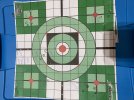It’s been a couple weeks since I shot my full power work ups with varget and the 315. Seems like it’s going in the right direction. Going to give the 36.0 grain load another chance, thinking the one flyer may have been me, or one a little heavy on the PC, or who knows what else. Going to pay real close attention to the fine details on the next round. Overall it’s coming around. Had a couple loads with 311-332 and they shot better than anticipated. I’ve got quite a bit left to try and some adjustments to make after I settle on a powder charge. Hoping I can shorten my COAL up about .010-.020 to make chambering a little smoother. I have them all shoved pretty much into the lands and very tight when closing the bolt.
Going to load 36.0, 36.5, 37.0, 37.5, and 38.0 and see if they tighten up anymore or start opening back up. Guess that will tell me where to settle and start tweaking COAL, and Go from there.
50 yards, all sized to .311
Going to load 36.0, 36.5, 37.0, 37.5, and 38.0 and see if they tighten up anymore or start opening back up. Guess that will tell me where to settle and start tweaking COAL, and Go from there.
50 yards, all sized to .311


